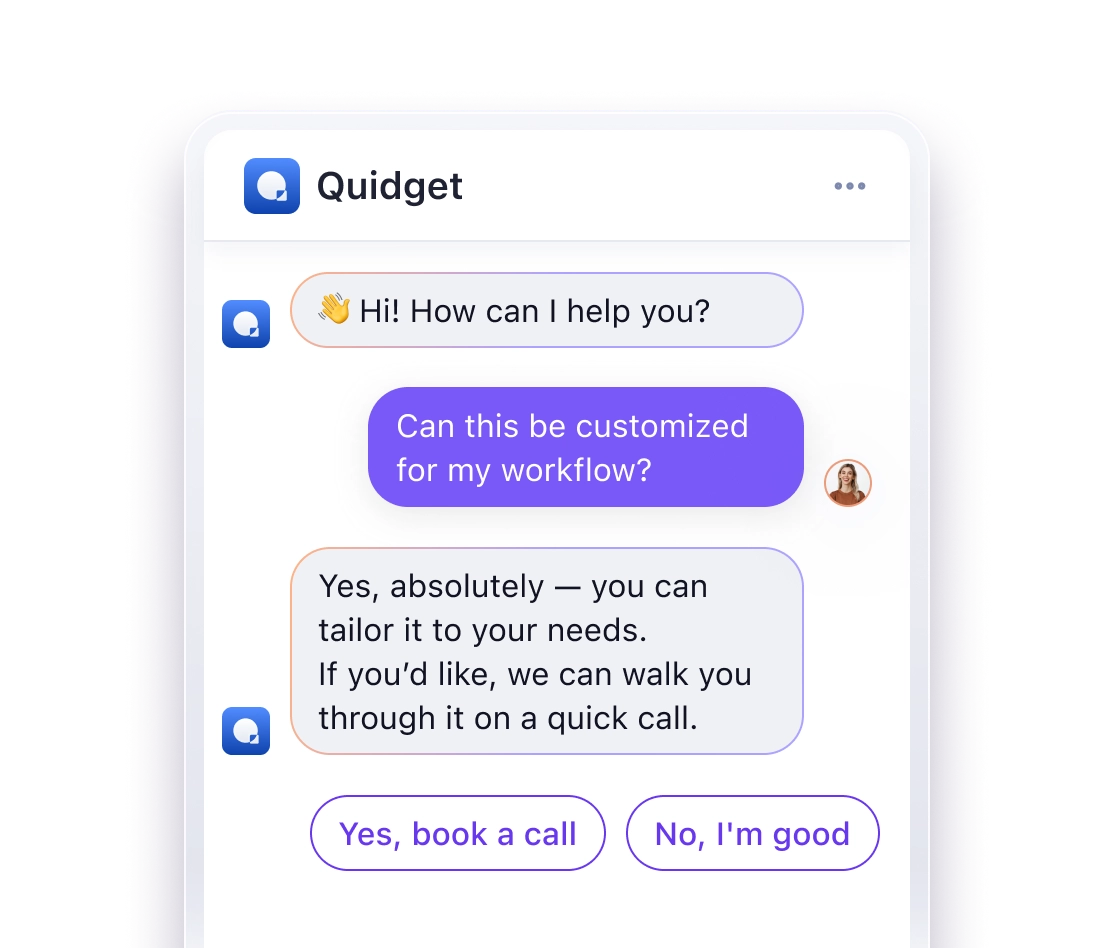AI chatbots are reshaping customer interactions by combining technology with psychology. To make conversations effective, chatbots need to focus on empathy, trust, and smooth conversational flow. Here’s what matters most:
- Empathy: Recognize emotions and respond supportively.
- Trust: Build user confidence with consistent, reliable interactions.
- Natural Flow: Maintain context and use personalized responses.
- Emotional Awareness: Use tools like sentiment analysis and emotion detection.
For example, tools like Quidget excel by blending emotional recognition with practical solutions, handling 80% of queries while seamlessly transitioning complex cases to human agents. By applying psychological principles, businesses can improve user satisfaction, reduce costs, and boost engagement. Ready to learn how psychology drives chatbot success? Let’s dive in.
Using Empathy in Chatbot Design
What Is Chatbot Empathy?
Empathy plays a key role in creating effective chatbots. It allows chatbots to grasp user emotions, turning simple conversations into meaningful interactions. Research indicates that while AI chatbots are great at maintaining conversational flow, they often fall short when it comes to emotional connection. This gap makes empathy an essential factor in improving user satisfaction.
Incorporating empathy into chatbots requires a mix of technical expertise and psychological insight.
How to Make Chatbots More Empathetic
Adding empathy to chatbots involves combining advanced technology with an understanding of human emotions. Here are some ways chatbots can deliver empathetic responses:
| Empathy Feature | Implementation Method | User Impact |
|---|---|---|
| Emotional Recognition | Using Natural Language Processing (NLP) to analyze user messages | Identifies user sentiment effectively |
| Contextual Understanding | Tailoring responses based on conversation history | Makes interactions feel more personal |
| Supportive Language | Leveraging pre-trained models to acknowledge emotions | Helps users feel understood and supported |
| Adaptive Tone | Adjusting tone in real-time to match the user’s mood | Ensures communication feels appropriate |
For example, if a user expresses frustration, a chatbot might respond with: "I can see this is frustrating. Let’s work through it together."
Case Study: Quidget‘s Empathy in Action

Quidget serves as a great example of how empathy can improve chatbot performance. Their AI support agent blends emotional recognition with practical solutions, offering support in more than 80 languages.
One standout feature of Quidget is its ability to recognize when a situation is too complex for AI alone. In such cases, it seamlessly transitions the conversation to a human agent while keeping the context and emotional tone intact.
Quidget’s empathetic design has led to impressive results, handling 80% of customer queries effectively. This approach achieves several key outcomes:
- Earns user trust with emotionally appropriate and consistent responses
- Minimizes frustration by addressing concerns quickly and thoughtfully
- Delivers personalized support at scale without losing the human element
Quidget showcases how prioritizing empathy in chatbot design can improve both performance and user experience.
Using Psychology to Improve Chat Interactions
Common Mental Shortcuts in Chat
Understanding how people think and make decisions can make chatbots more effective. Users often rely on mental shortcuts, known as cognitive biases, when interacting with AI chatbots.
| Mental Shortcut | What It Means | How It Shapes Chat Design |
|---|---|---|
| Anchoring | People depend on the first info they see | Start with the best solution to guide users |
| Framing | How info is presented influences choices | Highlight benefits to encourage decisions |
| Confirmation Bias | People prefer info that supports their views | Share balanced info while respecting beliefs |
Applying Psychology to Chatbots
Research into human-AI interactions shows that psychological principles can make chatbots more effective. The trick is to focus on emotional dynamics that improve user experiences.
Here are two key areas developers can focus on:
- Cognitive Fluency: Use language that’s simple and easy to understand.
- Personalization: Adjust responses based on user history and tone, making conversations feel more tailored.
Psychology in Practice
An analysis of 35,000 interactions revealed seven common ways people interact with AI, ranging from personal sharing to casual small talk. However, a study of 155 conversations pointed out a key issue: while GPT-based chatbots performed well in conversation quality, they lacked empathy compared to human partners. This has led to advancements in tools that focus on emotional awareness.
Modern chatbot platforms now use these tools to improve interactions:
- Sentiment Analysis: Tracks user emotions in real time.
- Affect Prediction: Anticipates how users might feel and prepares responses.
- Automatic Emotion Recognition: Detects and responds to user emotions effectively.
Creating Trust Through Better Conversations
Making Conversations Feel Natural
Trust begins with dialogue that feels real and not overly mechanical. Studies highlight that users are more receptive to chatbots that follow logical conversation patterns and show an understanding of context.
Today’s chatbots leverage NLP to keep track of context, detect emotions, and adjust their tone. This helps create conversations that feel human-like without crossing into the "uncanny valley". The key is to be helpful while being upfront about the chatbot’s AI nature.
Adding small, personal touches can also make interactions more engaging and trustworthy.
Adding Personal Elements to Chats
Personalization goes a long way in making conversations more engaging and trust-worthy. At the same time, it’s essential to prioritize user privacy. Here’s how top chatbots balance personalization and data protection:
| Personalization Method | Privacy Approach |
|---|---|
| Conversation History | Retain only necessary details |
| User Preferences | Always request explicit consent |
| Data Management | Remove identifiable information |
How Quidget Builds User Trust
Quidget sets a strong example for earning user trust through its thoughtful features. It handles 80% of routine customer queries while ensuring interactions feel natural and seamless:
Reliable Support: Quidget offers 24/7 assistance and smart escalation. Users get smooth transitions between AI and human agents, ensuring consistent help whenever needed.
Language Flexibility: With support for over 80 languages, Quidget ensures users can communicate clearly in their preferred language.
These features highlight how successful chatbots strike a balance between automation and genuine interaction, aligning with the empathy-first design principles mentioned earlier.
sbb-itb-58cc2bf
Testing and Improving Chatbot Results
Key Metrics to Watch
To ensure a chatbot performs well, it’s important to track metrics that show how efficiently it works and how users feel about it. Some of the most useful metrics include:
- User engagement, such as click-through rates, to measure how often users interact with the bot.
- Resolution success, or the percentage of queries the bot resolves without needing human help.
- User satisfaction, often measured through CSAT scores, which reflect how happy users are with their experience.
These metrics not only gauge technical performance but also highlight how users emotionally respond to the chatbot. Pair these numbers with user feedback for a clearer picture of what’s working and what’s not.
Using Feedback to Improve
Short, well-timed in-chat surveys can reveal how users feel about their experience and whether their issues were resolved smoothly. This kind of feedback sheds light on emotional or usability challenges, helping refine the chatbot’s design to better meet user needs.
In addition to direct feedback, advanced analytics tools offer valuable insights into user behavior and sentiment during interactions.
Tools for Chatbot Analysis
Analytics platforms today go beyond basic data to explore the emotional dynamics of user interactions. For example, Quidget’s analytics suite specializes in improving the emotional quality of chatbot conversations by:
- Pinpointing moments where users experience frustration or confusion.
- Analyzing sentiment trends to make the bot more empathetic.
- Tracking how well the bot resolves issues while ensuring users remain comfortable throughout the process.
For the best results, combine insights from analytics tools with manual reviews of chat transcripts. This mix of data-driven and hands-on approaches helps improve both the bot’s technical capabilities and its ability to connect with users on a human level.
Designing Emotional Health Chatbots
Conclusion: Making Psychology Work in Chatbots
Incorporating psychology into chatbot design has reshaped customer support. With chatbots handling 65% of B2C communications, understanding their psychological effects has become essential. These developments aren’t just theoretical – they lead to real business outcomes.
Chatbots designed with psychological principles can increase sales by 67% and reduce support costs by 30%. This is achieved by focusing on empathy, personalization, and creating a natural conversational flow. Tools like Quidget showcase these ideas in action, delivering high resolution rates by addressing human needs effectively.
The path forward for chatbots lies in refining empathy models and gaining deeper insights into human-AI interactions. Research shows that chatbots capable of recognizing emotions and offering tailored support are seen as more reliable and better equipped to meet customer expectations.



